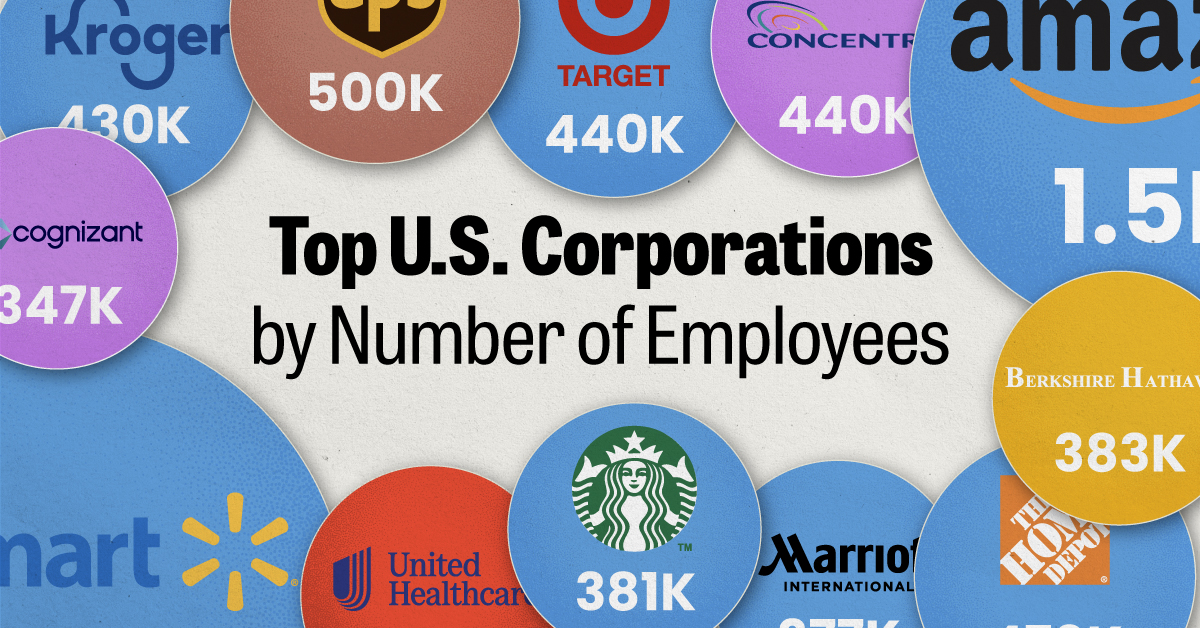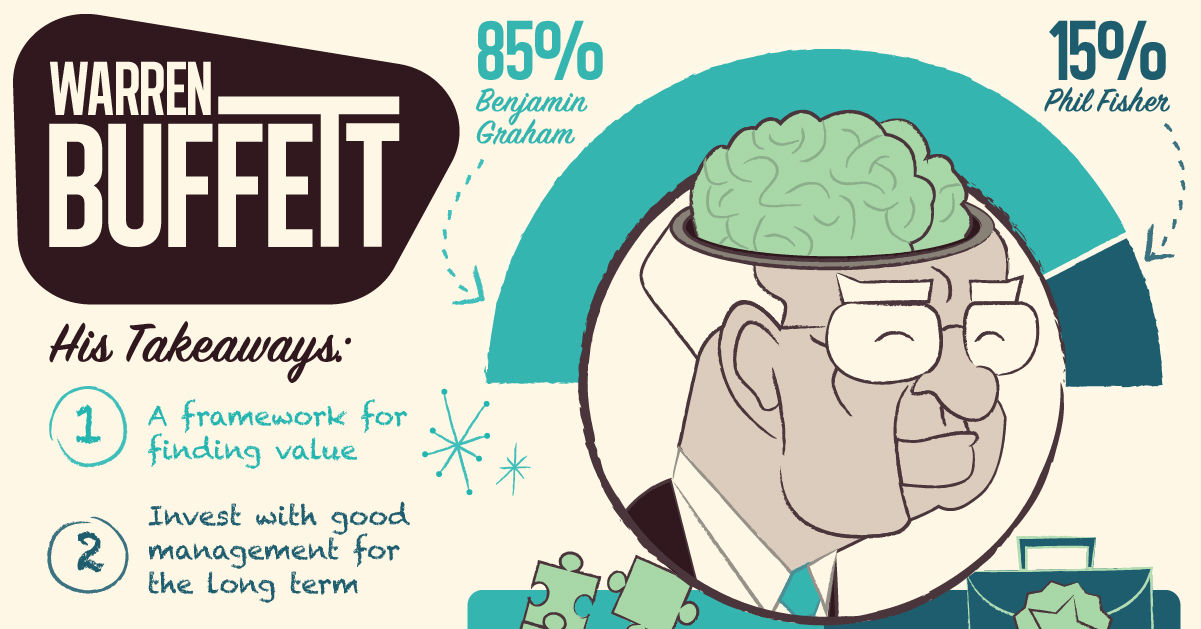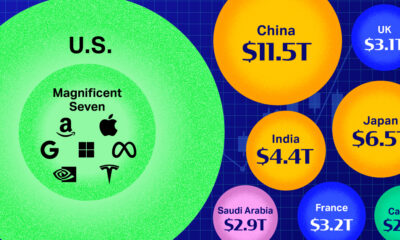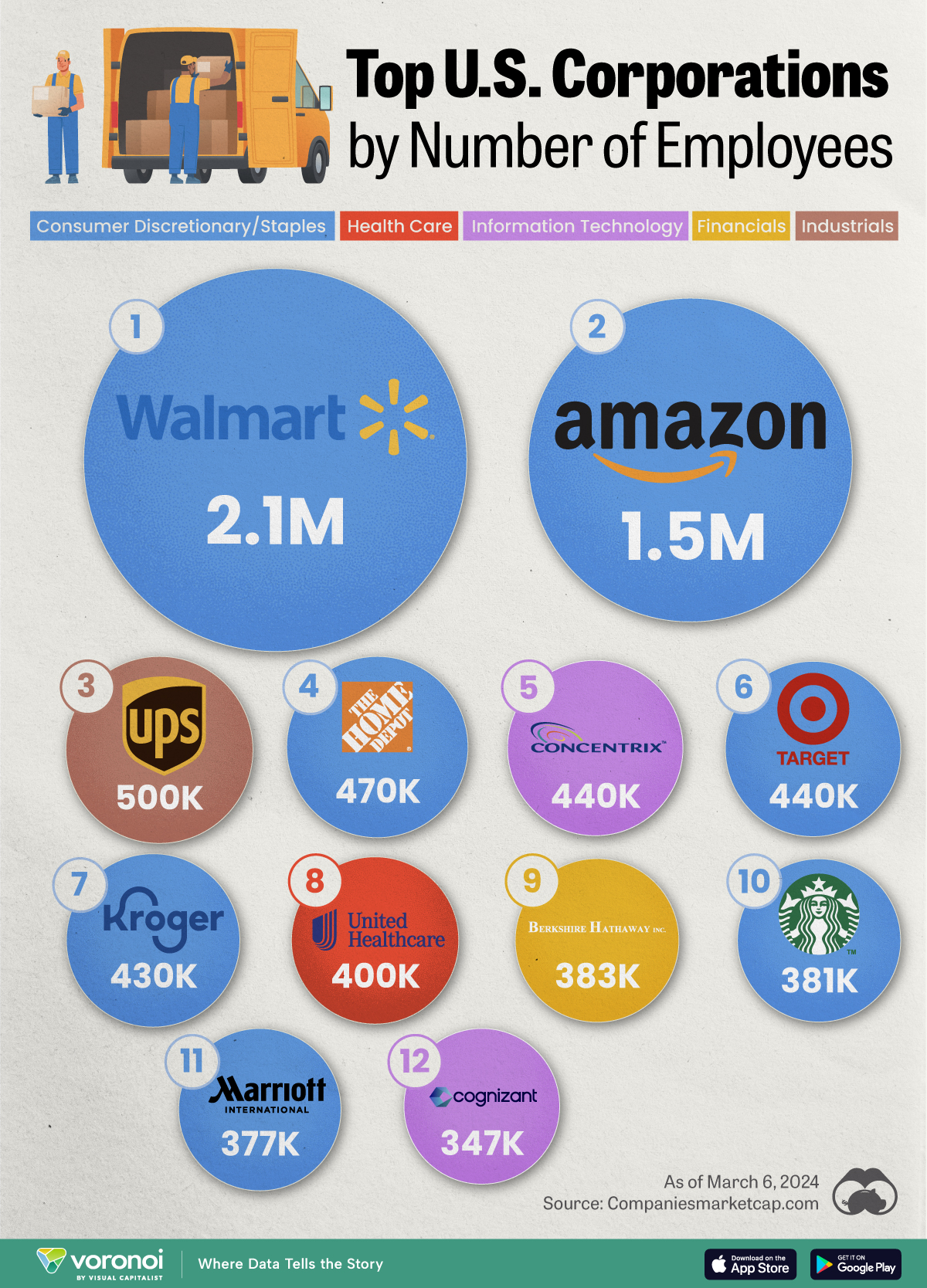Markets
Inside Warren Buffett’s Brain
What springs to mind when you think of legendary investor Warren Buffett?
For some, it’s his humble Omaha origins or his long-lasting obsession with Coca-Cola. For other people, it’s Buffett’s impeccable investing track record and extraordinary wealth that make a lasting impression.
While these are all legitimate connections to make with the Buffett name, perhaps he is most synonymous with the discipline of value investing – the style and mindset Buffett has made famous over the decades.
The Warren Buffett Series
Part 2: Inside Buffett’s Brain
Today’s infographic provides a deep dive into Warren Buffett’s brain, and it explains everything about his investing philosophy, along with the framework he uses to evaluate potential opportunities.
It’s the second part of the Warren Buffett Series, which we’ve done in partnership with finder.com, a personal finance site that helps people make better decisions – whether they want to jump on the cryptocurrency craze or follow Buffett’s more traditional path to financial success.

Note: Stay tuned for future parts with our free mailing list.
Warren Buffett’s investment philosophy is well-known.
He famously focuses on the intrinsic value of companies, and he buys stocks when they are “on sale”. Buffett’s not afraid to accumulate big positions in companies he likes – and his favorite holding period is “forever”.
While this formula may seem simple on paper, it’s extremely nuanced and complex in practice.
How Does Buffett’s Brain Work?
Warren Buffett has said that he borrows 85% of his investing style from Benjamin Graham, and 15% from Phil Fisher.
Benjamin Graham:
The godfather of value investing gave Buffett a framework for finding undervalued assets and companies.
Phil Fisher:
The famous growth investor showed Buffett the importance of investing with good management teams.
According to writer Robert Hagstrom, Buffett applies these ideas by focusing on four key principles of investing:
1. Analyze a stock as a business
Have the priorities of a business owner and look the company from a long-term perspective.
Is it increasing its intrinsic value? Would you want to own the entire company?
2. Ensure a “margin of safety”
Buffett considers “margin of safety” the three most important words in investing.
In other words, does a company have more intrinsic value than book value?
3. Manage a focused portfolio
Concentrate on a few stocks that will provide above-average returns over time. Buffett suggests investors think of this as owning a “punch card” with just 20 investment choices that can be made over a lifetime.
4. Protect yourself from Mr. Market
Mr. Market can be speculative and emotional, and he should not be relied upon as a predictor of future prices.
Instead, take advantage of Mr. Market periodically, whenever there is a fire sale.
Buffett’s Investment Criteria
Here are 12 key factors Warren Buffett considers when looking at potential opportunities:
1. Simplicity
Is the business easy to understand?
2. Operating History
Has the business been around for a long time, with a consistent operating history?
3. Long-Term Prospects
Is there reason to believe that the business will be able to sustain success in the long-term?
4. Rational Decisions
Is management wise when it comes to reinvesting earnings or returning profits to shareholders as dividends?
5. Candidness
Does the management team admit mistakes? Are they honest with shareholders?
6. Resisting the “Institutional Imperative”
Can the company resist temptations created by institutional dynamics, such as imitating peer companies, or resist changes in direction?
7. Profit Margins
Does the company have high profit margins?
8. Return on Equity
What is the return on equity (ROE) of the business?
9. Owners Earnings
What is the company’s ability to generate cash for shareholders, who are the residual owners? This is technically defined as free cash flow to equity (FCFE).
10. One Dollar Premise
For every dollar retained from net income, does the company create at least one dollar of market value?
11. Intrinsic Value
What is the value of the future owners’ earnings, discounted back to the present?
12. Margin of Safety
What’s the chance you’ll lose money on the stock, in the long run, if you buy it at today’s price?
Or to sum all of these ideas up succinctly, here’s a quote from the man himself.
My strategy is to find a good business – and one that I can understand why it’s good – with a durable, competitive advantage, run by able and honest people, and available at a price that makes sense.
– Warren Buffett
Other Notes
Part 3 of the Warren Buffett Series will be released in late February 2018.
Credits: This infographic would not be possible without the great biographies done by Roger Lowenstein (Buffett: The Making of an American Capitalist) and Alice Schroeder (The Snowball), as well as numerous other sources cataloging Buffett’s life online.
Markets
Ranked: The Largest U.S. Corporations by Number of Employees
We visualized the top U.S. companies by employees, revealing the massive scale of retailers like Walmart, Target, and Home Depot.

The Largest U.S. Corporations by Number of Employees
This was originally posted on our Voronoi app. Download the app for free on Apple or Android and discover incredible data-driven charts from a variety of trusted sources.
Revenue and profit are common measures for measuring the size of a business, but what about employee headcount?
To see how big companies have become from a human perspective, we’ve visualized the top U.S. companies by employees. These figures come from companiesmarketcap.com, and were accessed in March 2024. Note that this ranking includes publicly-traded companies only.
Data and Highlights
The data we used to create this list of largest U.S. corporations by number of employees can be found in the table below.
| Company | Sector | Number of Employees |
|---|---|---|
| Walmart | Consumer Staples | 2,100,000 |
| Amazon | Consumer Discretionary | 1,500,000 |
| UPS | Industrials | 500,000 |
| Home Depot | Consumer Discretionary | 470,000 |
| Concentrix | Information Technology | 440,000 |
| Target | Consumer Staples | 440,000 |
| Kroger | Consumer Staples | 430,000 |
| UnitedHealth | Health Care | 400,000 |
| Berkshire Hathaway | Financials | 383,000 |
| Starbucks | Consumer Discretionary | 381,000 |
| Marriott International | Consumer Discretionary | 377,000 |
| Cognizant | Information Technology | 346,600 |
Retail and Logistics Top the List
Companies like Walmart, Target, and Kroger have a massive headcount due to having many locations spread across the country, which require everything from cashiers to IT professionals.
Moving goods around the world is also highly labor intensive, explaining why UPS has half a million employees globally.
Below the Radar?
Two companies that rank among the largest U.S. corporations by employees which may be less familiar to the public include Concentrix and Cognizant. Both of these companies are B2B brands, meaning they primarily work with other companies rather than consumers. This contrasts with brands like Amazon or Home Depot, which are much more visible among average consumers.
A Note on Berkshire Hathaway
Warren Buffett’s company doesn’t directly employ 383,000 people. This headcount actually includes the employees of the firm’s many subsidiaries, such as GEICO (insurance), Dairy Queen (retail), and Duracell (batteries).
If you’re curious to see how Buffett’s empire has grown over the years, check out this animated graphic that visualizes the growth of Berkshire Hathaway’s portfolio from 1994 to 2022.
-

 Business2 weeks ago
Business2 weeks agoAmerica’s Top Companies by Revenue (1994 vs. 2023)
-

 Environment1 week ago
Environment1 week agoRanked: Top Countries by Total Forest Loss Since 2001
-

 Markets1 week ago
Markets1 week agoVisualizing America’s Shortage of Affordable Homes
-

 Maps2 weeks ago
Maps2 weeks agoMapped: Average Wages Across Europe
-

 Mining2 weeks ago
Mining2 weeks agoCharted: The Value Gap Between the Gold Price and Gold Miners
-

 Demographics2 weeks ago
Demographics2 weeks agoVisualizing the Size of the Global Senior Population
-

 Misc2 weeks ago
Misc2 weeks agoTesla Is Once Again the World’s Best-Selling EV Company
-

 Technology2 weeks ago
Technology2 weeks agoRanked: The Most Popular Smartphone Brands in the U.S.




















